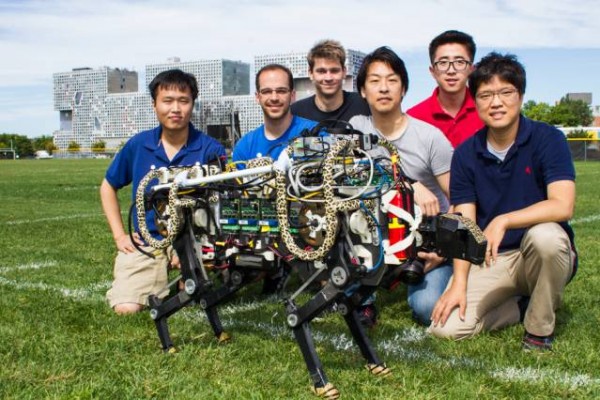MIT Develops Incredible Robot Cheetah that Runs up to 30 mph
| Ana Verayo | | Sep 16, 2014 01:56 AM EDT |
(Photo : Jose-Luis Olivares/MIT) MIT cheetah-bot experiment in Briggs Field. (From left) Sehyuk Yim, Joao Luiz Almeida Souza Ramos, Wyatt L Ubellacker, Sangbae Kim, Xu Sun, and Hae Won Park.
Researchers from MIT have developed a unique algorithm for bounding that enables a robotic cheetah to run free and jump untethered to any support frame.
With this algorithm, researchers can control the cheetah's bounding and adjust it to many speeds and triple the force when the robot performs jumps and obstacles.
Like Us on Facebook
"Robo- cheetah" is able to sprint at 10 miles per hour and jump over hurdles. It can accelerate to speeds of up to 30 miles per hour.
The secret of the algorithm is that it has a program for each of the robot's legs. Each leg exerts a certain amount of force the moment it hits the ground, allowing the robot to maintain a steady sprint at any speed.
Sprinters such as Usain Bolt, who is the fastest person on Earth, don't cycle their legs at a really fast rate to run faster. The secret is they increase the length of their stride, said Sangbae Kim, an associate professor for mechanical engineering at MIT.
This enables a human runner or a robot to maintain a steady frequency by exerting harder force downward, and at the same time, increasing their ground force.
By adapting this technique involving ground force, researchers allowed the Robo-cheetah to run on terrain like a grassy field.
Kim said the majority of robots are slow and heavy because they don't control force at any given high speed situation.
The MIT cheetah is unique because it enables control of this force, even for a short period of time. This control results in a powerful impact on the ground and produces an agile and dynamic robot.
The robot's machinery includes high-torque-density electric motors controlled by amplifiers that enhance the biomorphic inspired legs. It also adapts well to rough terrain.
This algorithm makes it easier to determine how much force each leg needs to exert within a short period of time it makes contact with the ground.
TagsMIT Develops Incredible Robot Cheetah, MIT, robot cheetah, MIT cheetah robot, Robots, algorithm for robot cheetah, usain bolt, cheetahs
©2015 Chinatopix All rights reserved. Do not reproduce without permission
EDITOR'S PICKS
-

Did the Trump administration just announce plans for a trade war with ‘hostile’ China and Russia?
-

US Senate passes Taiwan travel bill slammed by China
-

As Yan Sihong’s family grieves, here are other Chinese students who went missing abroad. Some have never been found
-

Beijing blasts Western critics who ‘smear China’ with the term sharp power
-

China Envoy Seeks to Defuse Tensions With U.S. as a Trade War Brews
-

Singapore's Deputy PM Provides Bitcoin Vote of Confidence Amid China's Blanket Bans
-

China warns investors over risks in overseas virtual currency trading
-

Chinese government most trustworthy: survey
-

Kashima Antlers On Course For Back-To-Back Titles
MOST POPULAR
LATEST NEWS
Zhou Yongkang: China's Former Security Chief Sentenced to Life in Prison

China's former Chief of the Ministry of Public Security, Zhou Yongkang, has been given a life sentence after he was found guilty of abusing his office, bribery and deliberately ... Full Article
TRENDING STORY

China Pork Prices Expected to Stabilize As The Supplies Recover

Elephone P9000 Smartphone is now on Sale on Amazon India

There's a Big Chance Cliffhangers Won't Still Be Resolved When Grey's Anatomy Season 13 Returns

Supreme Court Ruled on Samsung vs Apple Dispute for Patent Infringement

Microsoft Surface Pro 5 Rumors and Release Date: What is the Latest?










